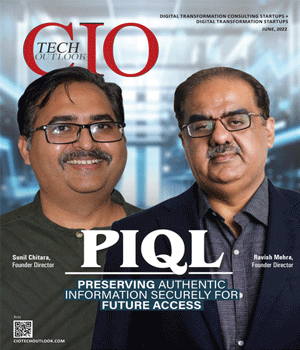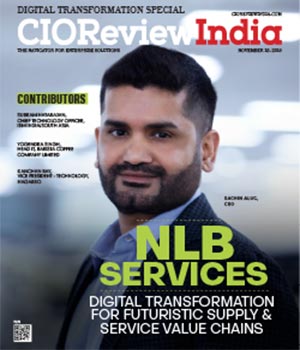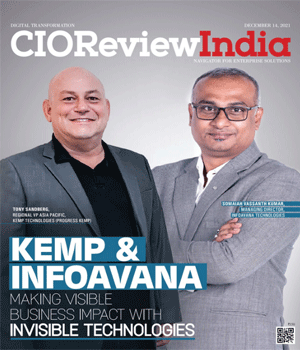
Significance of data-driven approach to Digital Transformation
Hemant Tiwari, Managing Director, India, Hitachi Vantara | Tuesday, 14 March 2023, 10:11 IST

Excerpts from a conversation with Hemant Tiwari, Managing Director, India, Hitachi Vantara in which he walks us through the market opportunities and challenges in enabling digital transformation and how accelerated digitalization has positively transformed various aspects of our economy, society, and environment.
Business cultures that are resistant to change obstruct progress. Nevertheless, when it comes to digital transformation, we observe this risk-averse mentality in many businesses. The adoption of new technology is met with some opposition, from C-level executives to staff. What should be the approach for change management during digital transformation?
Digital transformation is the integration of digital technology into all aspects of a business, fundamentally altering how it operates and providing value to customers. It is also a cultural shift that requires organizations to constantly challenge the status quo, experiment and become comfortable with failure, learn & move forward.
Hybrid clouds provide tools to help automate businesses, thereby enabling the enterprise to allocate more resources to strategic pursuits. Cloud solutions enable organizations to cut costs and increase profitability while improving agility, efficiency, and productivity. They also give teams the tools they need to do their jobs quickly and easily, without over-allocation, freeing the staff for more strategic pursuits with a simple, automated self-service system.
As an organization, it is important to focus on the following six areas during the digital transformation:
Transforming Operations: In every industry, companies with better operations create competitive advantage through superior agility, efficiency, and improved productivity. Technologies such as smartphones, big data analytics, social media collaboration, and embedded devices can break the paradox of the predigital age. Mobile and collaboration technologies help orchestrate employees more closely. It is important to free oneself from old assumptions of predigital age, look for bottlenecks and inefficiencies in processes and consider what digital technologies can help rethink processes. A strong digital platform is essential for operational transformation. Cloud-native solutions and DevOps with data service application platforms and Kubernetes could provide improved efficiency and productivity, greater agility in the marketplace, and the flexibility to put data and applications where they are needed.
Digital Technologies: Embracing technologies like OT (operational technology) and IT, IoT, cloud, social media, Analytics, Mobility & embedded devices help maximize success in the digital world. Simply investing in these technologies does not help improve the bottom line, better earnings, and net income, it is how they lead change that makes these companies digital masters, placing them way ahead of those digital laggards. Digital masters excel in two critical aspects – the what of Technology, known as digital capabilities, and how they lead change (the leadership capabilities).
Data Insights: Businesses that are driven by insights are growing rapidly. By focusing on digital infrastructure, data management, as well as digital solutions, enterprises can analyze and extract insights from large amounts of data, develop new business models, and create ensuing values. Additionally, putting customer experience at the heart of digital transformation helps improve customer experience, increases reach and engagement makes data and analytics the lifeblood of customer experience besides opening new possibilities.
Engaging the Organisation at Scale: Leading digital makes it imperative for organizations to create a compelling digital vision for the future. This must be followed by finding ways to engage and energize employees to make the digital vision a reality. Digital technology makes it possible to engage employees at scale and helps transform people, culture, processes, and organization, empowering leaders and employees to be more agile, responsive, and collaborative. Crowd-sourcing employees to co-create solutions accelerate buy-in, thereby, having a profound impact on powerful outcomes and customer experiences. Finally, leadership is key to leading change by framing digital challenges, focusing investments, mobilizing the organization at scale, and sustaining the transition to digital.
Social Innovation: An organization’s approach towards its social and environmental commitments decides its future workplace. Data-driven insights, combined with domain expertise and digital prowess, help enterprises get more value from their business systems by deploying solutions that integrate seamlessly during the digital transformation of social infrastructure.
Partner Ecosystem: A supportive ecosystem multiplies the power of digital transformation and enables more flexible and responsive solutions.
The secret to overcoming the obstacles of digitalization is effective communication. Therefore, it is critical to promote familiarity with the digital culture, tools, technology, and solutions among employees and other stakeholders. How can this be ensured?
Mahatma Gandhi famously said, “Be the change you wish to see in the world”. This holds good for leading digital transformation. As a leader, it is essential to be a role model for change. “Think digital first”. By acting as a role model for desired change, a leader also encourages employees to think the same, thereby, earning the right to engage employees for change. The first step in transforming and digitalizing your business is to ensure a compelling digital vision and focused investment strategy are in place and transformation is a priority for your organization. It is important to market and effectively communicate the ambitions and benefits of digital transformation within an organization, building sufficient momentum, thereby earning the right to engage as a leader and setting new behaviors by encouraging a cultural shift by using digital technologies to change the way people work, collaborate and co-create. Digital transformation must be treated as the foundation to co-create a new business model, which is then driven by the organization’s teams across departments.
New ways of working, powered by digital technologies, are evolving cultures and work practices within organizations. Leaders & organizations must identify digital champions within (those who are true believers), identify quick wins, set new behaviors, make visible changes to work practices and institutionalize them, encourage adoption and not deployment, and, finally, a culture of learning to fail quick must be established. In summary, these steps define how organizations mobilize the workforce, drive a cultural shift, and help employees and organizations become more agile, responsive, and collaborative.
Organizations must not only hire the right talent, but they must also undertake continual efforts to help them stay updated with the constantly evolving landscape of the tech industry. We believe in providing rigorous training to our employees, including the freshers, on new-age technologies to make them business-ready. Similarly, initiatives such as career enhancement programs and sponsored technical certifications/soft skills programs go a long way in helping teams transition to digital ways of working.
Apart from employees, it is also crucial to effectively and delicately manage other stakeholders, such as directors, shareholders, customers, and the government. Business leaders need to put themselves forward to lead a project at work or undertake further studies to gain a valued qualification alongside work experience to implement sustainable change and deliver sustainable outcomes. To begin with, we should analyze and understand different stakeholders’ priorities and be aligned with their digitalization goals, define success measurements, and manage their expectations. Stakeholders’ input may not be needed for the entire project but it is important to engage them in the decision-making process to make them feel that their voices are heard.
Enterprises are making large investments in digital technology. Investment in digital transformation is expected to increase from USD 1.8 trillion in 2022 to USD 2.8 trillion in 2025. How do you see this transformation in the future?
Undoubtedly, the future belongs to the data-driven. In the coming years, businesses will continue to leverage the new digital foundations that are being established and scale up from there. Accelerated digitalization has positively transformed various aspects of our economy, society, and the environment - it is the new normal. According to McKinsey, data-driven organizations are 23 times more likely to win customers, six times more likely to keep customers, and 19 times more likely to be profitable than the laggards in customer analytics.
Businesses are now focused on building an IT roadmap to ensure that they can deliver fast, agile, high-quality, and secure application services across multiple sites and providers. The top traits among them include the global delivery of services, business continuity, cloud-smart flexibility, and cost management. A factor that will play a key role in this process is the adoption of the cloud. Majority of the enterprises today have understood the value that cloud adoption can provide and are at different stages in their cloud journeys. Hybrid cloud adoption is growing exponentially and becoming a popular choice as a distributed cloud model. The pandemic has undoubtedly been an accelerator in this process, and the growth is only expected to be boosted in the coming years. Data infrastructure is no longer bound by a physical location, and the infrastructure is evolving into a new IT operating model based on the hybrid cloud.
CIO Viewpoint
The Constantly Evolving Technology Landscape in...
By Janifha Evangeline
Navigating the Digitalization of Mining Industry
By Janifha Evangeline
How To Achieve An Effective Digital Transformation
By Yogendra Singh, Head-IT/SAP, Barista Coffee Company Limited
CXO Insights
No-code platforms: Enterprise-wide Adoption...
By Rahul Murthi, Director at Acies
Unleashing the Potential of IT in Engineering...
By Gyan Pandey, Head - Digital/CDO, Voltas
Low Code and Artificial Intelligence - The...



.jpg)

.jpg)





